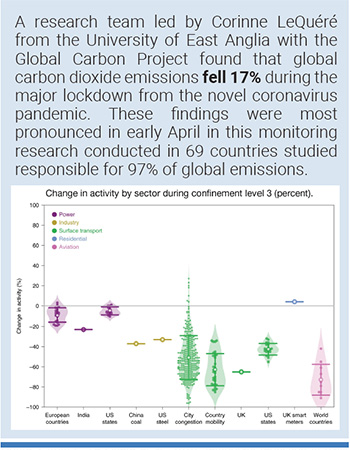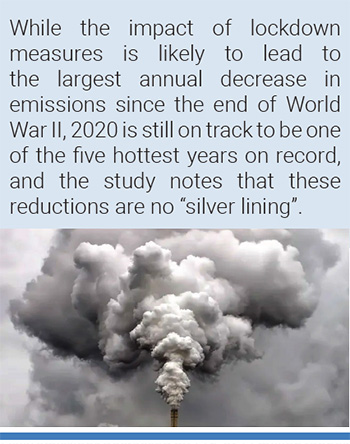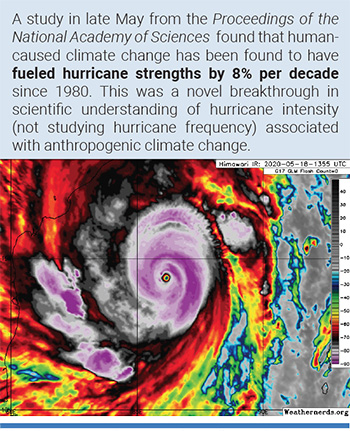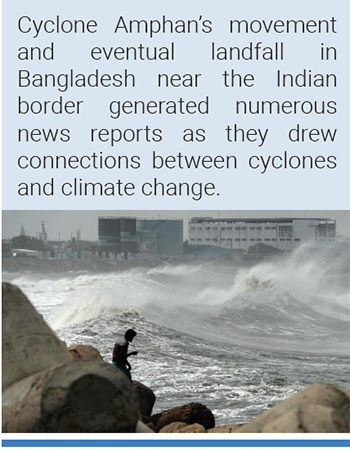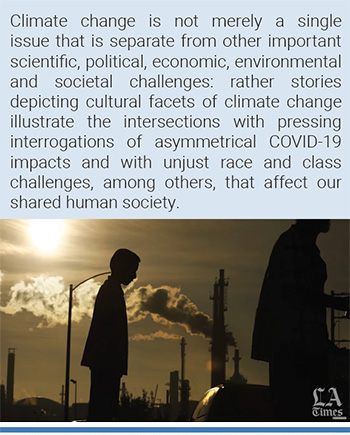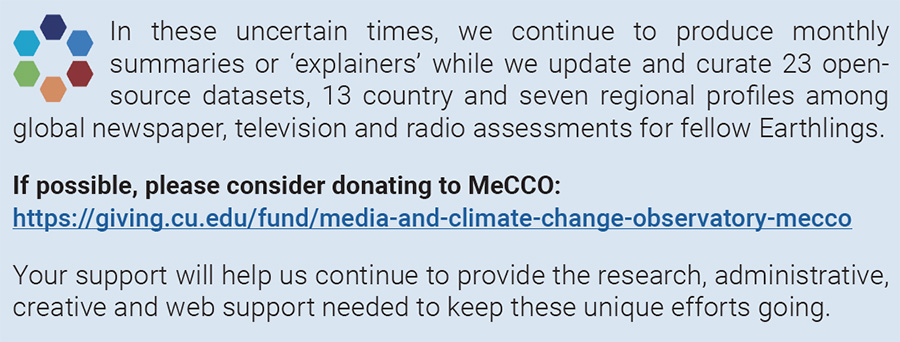Monthly Summaries
Issue 41, May 2020
[DOI]

As people around the world stay home, air pollution is down and urban wildlife sightings are up. Source: Associated Press.

May 2020 has been a pivotal month in human history. Amid accelerated learning and intense behavior change, media attention to climate change and global warming at the global level increased slightly (0.2%) from April 2020 coverage. Compared to a year earlier (May 2019), much like the precipitous drop detected April 2019-April 2020, the number of news articles and segments about climate change and global warming in May 2020 dropped dramatically as well. Coverage May 1-31, 2020 through our Media and Climate Change Observatory (MeCCO) monitoring of 120 media sources in 56 countries and ten languages all across the planet has found a 52% drop from May 1-31, 2019. Regionally, the ongoing stream of stories in this past May increased in the Middle East (up 8%), Latin America (up 28%) and Oceania (up 30%). In contrast, coverage was decreased in Asia (down nearly 1%), Africa (down 22%) and North America (down 21%) from the previous month. Also in May 2020, coverage from international wire services – The Associated Press, Agence France Presse, The Canadian Press, and United Press International – dropped 4% from the month before while contracting 63% from May 2019.
Figure 1 shows trends in newspaper media coverage at the global scale – organized into seven geographical regions around the world – from January 2004 through May 2020.

Figure 1. Newspaper media coverage of climate change or global warming in print sources in seven different regions around the world, from January 2004 through May 2020.
At the country level, media coverage of climate change or global warming climbed most significantly in May 2020 from the month before in Spain (up 46%), followed by Russia (up 42%), New Zealand (up 31%) Australia (up 30%), India (up 17%), Norway (up 15%), Sweden (up 7%) and Germany (up 6%). Meanwhile, coverage dropped most dramatically in Canada (plummeting 45%), the United States (US) (slumping 28% in print and 26% in television), Japan (declining 22%) and the United Kingdom (falling 7%) in May 2020 compared to the previous month of April.

Figure 2. German newspaper media coverage of climate change (‘klimawandel’) or global warming (‘globale erwärmung’) in Süddeutsche Zeitung and Die Tageszeitung, from January 2004 through May 2020.
Figure from C. Le Quéré et al., 2020. Temporary reduction in daily global CO2 emissions during the COVID-19 forced confinement. Nature Climate Change. |
Looking to content in May, scientific research and findings about various dimensions of climate change or global warming attracted ample media attention in the larger stream of overall coverage. For example, a study published in early May in the Proceedings of the National Academy of Sciences found that by 2070 up to 33% of the global human population will be living in places that are inhabitable due to heat. Study authors Chi Xu, Timothy A. Kohler, Timothy M. Lenton, Jens-Christian Svenning, and Marten Scheffer pointed out that this will put particular pressure on vulnerable human communities at the forefront of climate impacts and will amplify climate-related adaptation and migration pressures. Associated Press journalist Seth Borenstein reported, “In just 50 years, 2 billion to 3.5 billion people, mostly the poor who can’t afford air conditioning, will be living in a climate that historically has been too hot to handle, a new study said. With every 1.8 degree (1 degree Celsius) increase in global average annual temperature from man-made climate change, about a billion or so people will end up in areas too warm day-in, day-out to be habitable without cooling technology, according to ecologist Marten Scheffer of Wageningen University in the Netherlands, co-author of the study. How many people will end up at risk depends on how much heat-trapping carbon dioxide emissions are reduced and how fast the world population grows”. Meanwhile, Environmental Editor Emma Gatten from The Telegraph in London wrote, “Humans have lived for 6,000 years in a “climate niche”, in which average annual temperatures stay below 25 degrees Celsius, according to the study by scientists from China, the US and Europe. Most people live in areas with temperatures less than 15 C. That range of temperatures is likely to represent fundamental constraints on what people need to survive, such as the ability to farm, the researchers said. But temperature increases as the result of greenhouse gas emissions could leave millions living in areas as hot as the hottest parts of the Sahara by 2070...”
Another study in early May – this appearing in Science Advances – found that humid heat also would play a part in the next 50 years in making some parts of planet Earth (where human societies have previously survived and thrived) uninhabitable. These stark findings grabbed media attention. For example, journalists Andrew Freedman and Jason Samenow reported, “Welcome to “Steambath Earth,” featuring sauna-like temperatures and humidity too high for humans to tolerate. Extremely humid heat that is more intense than most Americans have experienced — approaching a crucial, immovable human survivability limit — has more than doubled in frequency in some coastal subtropical regions of the world since 1979... The study is the first to find that wet-bulb temperatures of 95 degrees Fahrenheit (35 Celsius) — which render ineffective the human heat response of sweating to shed heat through evaporation, leading to hyperthermia — are already occurring for short periods of time at a few weather stations. These tend to occur in parts of the Persian Gulf shoreline and coastal southwest North America, where sizzling lands border sultry seas, as well as in northern South Asia, where extreme heat and humidity combinations overlap just before the annual monsoon season begins. With computer-model projections showing the world will continue to warm rapidly in response to increasing amounts of greenhouse gases in the atmosphere, the study, published Friday in the journal Science Advances, warns that highly populated regions of the world will be rendered uninhabitable sooner than previously thought for parts of each year. This will happen unless people take wide-ranging and costly steps to adapt to the heat during the next few decades, while nations undertake measures to slash emissions of greenhouse gases. The study depicts a world steadily marching toward a future in which many other locations approach or reach that survivability threshold, a trend that could throw a spotlight on the divide between rich nations that are able to adapt to this new reality and poor countries that suffer productivity losses and deaths”.
Daily emissions decreased by 17% or 17 million tonnes of carbon dioxide, globally during peak confinement measures in early April, dropping to levels last seen in 2006. Photo: Getty Images. |
Another study grabbing media attention in May was published in Nature. A research team led by Corinne LeQuéré from the University of East Anglia with the Global Carbon Project found that global carbon dioxide emissions fell 17% during the major lockdown from the novel coronavirus pandemic. These findings were most pronounced in early April in this monitoring research conducted in 69 countries studied responsible for 97% of global emissions. CBS News journalist Sophie Lewis reported, “Under coronavirus lockdowns, countries around the world have restricted travel and closed businesses. Flights were grounded and highways deserted. The major slowdown of movement has led to an "extreme" decline in carbon dioxide emissions — with daily levels 17% lower compared to averages from last year… daily emissions in early April, when most of the world was under strict lockdown measures, fell to levels last seen in 2006. Lockdowns could lead to an annual carbon emissions decline of up to 7% — the biggest drop since World War II, the researchers say…They point to massive decreases in transportation usage and industrial activities during the pandemic as the main sources of the decline”. Meanwhile, USA Today journalist Doyle Rice noted, “it is unlikely to last, according to a new analysis by an international team of scientists, who said the brief pollution break will likely be “a drop in the ocean” when it comes to climate change. This is the first analysis to measure the pandemic-driven global drop in carbon dioxide (CO2) emissions from January to April of this year. Carbon dioxide, emitted from burning fossil fuels such as oil, gas and coal, is the greenhouse gas that's most responsible for global warming. It stays in the atmosphere about a century before dissipating. While the impact of lockdown measures is likely to lead to the largest annual decrease in emissions since the end of World War II, 2020 is still on track to be one of the five hottest years on record, and the study notes that these reductions are no “silver lining”.
Then, as the official hurricane season in the Caribbean Basin was set to begin June 1, a study in late May from the Proceedings of the National Academy of Sciences found that human-caused climate change has been found to have fueled hurricane strengths by 8% per decade since 1980. This was a novel breakthrough in scientific understanding of hurricane intensity (not studying hurricane frequency) associated with anthropogenic climate change. For example, Washington Post journalists Andrew Freedman and Jason Samenow reported, “A new study provides observational evidence that the odds of major hurricanes around the world — Category 3, 4 and 5 storms — are increasing because of human-caused global warming. The implications of this finding… are far-reaching for coastal residents, insurers and policymakers, as the most intense hurricanes cause the most damage…“We’ve just increased our confidence of our understanding of the link between hurricane intensity and climate change,” said James Kossin, the lead author of the new study and a researcher with NOAA and the University of Wisconsin. “We have high confidence that there is a human fingerprint on these changes.”
Super Cyclonic Storm Amphan in the Bay of Bengal on May 18, 2020. Source: Weathernerds.org. |
In May, media coverage of climate stories with ecological and meteorological themes continued. Most prominently, Cyclone Amphan’s movement and eventual landfall in Bangladesh near the Indian border generated numerous news reports as they drew connections between cyclones and climate change. For example, CNN journalists Ben Westcott, Vedika Sud and Manveena Suri reported, “Millions of people in India and Bangladesh are in the path of a cyclone which is due to make landfall in less than 36 hours, bringing damaging winds and heavy rain to a region already struggling with the coronavirus pandemic. Super Cyclone Amphan became the strongest storm ever recorded in the Bay of Bengal on Monday night, after intensifying with sustained wind speeds of up to 270 kilometers per hour (165 miles per hours), according to data from the US Joint Typhoon Warning Center. Amphan has weakened slightly since, but the storm is still the equivalent of a Category 3 Atlantic hurricane, with winds speeds up to 185 kph (115 mph). The US Pacific Disaster Center (PDC) said up to 33.6 million people in India could potentially be exposed to the storm's winds, while a maximum of 5.3 million could be exposed in Bangladesh. The PDC's estimate is based on data from the Joint Typhoon Warning Center.”
Furthermore, journalist Jayashri Nandi from The Hindustan Times reported that super cyclone Amphan – the first to hit the Bay of Bengal since 1999 – made landfall in West Bengal in Bangladesh with impacts on Sundarbans mangrove forests. She noted, “Roxy Mathew Koll, a climate scientist at the Indian Institute of Tropical Meteorology, said Amphan has intensified extremely rapidly compared to other cyclones. “Since satellite data is available, such rapid intensification has not been seen. Cyclones draw energy from the ocean surface. So, sea surface temperature is an important factor. We are seeing record temperatures in some parts of the Bay of Bengal. Some buoys of the Indian National Centre for Ocean Information Services have recorded maximum temperature 32 to 34 degree Celsius during the first two weeks of May. That is linked to climate change surely and is one element which makes sure rapid intensification.”
Super Cyclone Amphan became the strongest storm ever recorded in the Bay of Bengal on May 18 after intensifying with sustained wind speeds of up to 270 kilometers per hour (165 miles per hours), according to data from the US Joint Typhoon Warning Center. Source: CNN. |
After making landfall, New York Times journalists Jeffrey Gettleman, Sameer Yasir, Kai Schultz and Hari Kumar reported, “Cyclone Amphan swept over the Bay of Bengal as the strongest cyclone ever recorded in the region. But...a phenomenon called vertical wind shear — the shifting of winds with altitude — had disrupted the storm’s rotational structure, weakening it. Amphan initially grew powerful because the waters it passed over were exceedingly warm, as high as 88 degrees in parts of the Indian Ocean. Warmer water provides more energy to fuel such rotating storms. Climate change is raising ocean temperatures, but other factors, including natural variability, can play a role. While it is not possible to say whether any one specific storm like Amphan was made more powerful by climate change, scientists have long expected that tropical storms like it will increase in strength as the world warms”.
Reflecting on Cyclone Amphan along with other recent meteorological and ecological events, New York Times journalist Somini Sengupta noted, “The hits came this week in rapid succession: A cyclone slammed into the Indian megacity of Kolkata, pounding rains breached two dams in the Midwestern United States, and on Thursday came warning that the Atlantic hurricane season could be severe. It all served as a reminder that the coronavirus pandemic, which has killed 325,000 people so far, is colliding with another global menace: a fast-heating planet that acutely threatens millions of people, especially the world’s poor. Climate change makes extreme weather events more frequent and more intense. Now, because of the pandemic, they come at a time when national economies are crashing and ordinary people are stretched to their limits...The worst may be yet to come. Several other climate hazards are looming, as the coronavirus unspools its long tail around the world. They include the prospect of heat waves in Europe and South Asia, wildfires from the western United States to Europe to Australia, and water scarcity in South America and Southern Africa, where a persistent drought is already deepening hunger”.
Meanwhile, links between climate change and locusts swarms in South Asia have emerged in May media coverage. For example, New York Times journalists Jeffrey Gettleman and Suhasini Raj reported, “As if India needed more challenges, with coronavirus infections steadily increasing, a heat wave hitting the capital, a recent killer cyclone and 100 million people out of work, the country now has to fight off a new problem: a locust invasion... Scientists say that this outbreak, similar to recent outbreaks in East Africa, is driven by the same factors: unusually warm weather and more rain. They blame climate change”.
The last time the United States consumed more renewable energy than coal was in the 19th century, when hydropower was just getting started and wood burning was a major fuel source. Source: CNN. |
In May, our MeCCO monitoring detected further media coverage of climate change or global warming relating to political and economic content. In particular, there were many news stories about how the novel coronavirus re-calibrated supply and demand for carbon-based energy sources as well as shifts to renewables. For example, New York Times journalist Brad Plumer wrote, “The United States is on track to produce more electricity this year from renewable power than from coal for the first time on record, new government projections show, a transformation partly driven by the coronavirus pandemic, with profound implications in the fight against climate change. It is a milestone that seemed all but unthinkable a decade ago, when coal was so dominant that it provided nearly half the nation’s electricity. And it comes despite the Trump administration’s three-year push to try to revive the ailing industry by weakening pollution rules on coal-burning power plants. Those efforts, however, failed to halt the powerful economic forces that have led electric utilities to retire hundreds of aging coal plants since 2010 and run their remaining plants less frequently. The cost of building large wind farms has declined more than 40 percent in that time, while solar costs have dropped more than 80 percent. And the price of natural gas, a cleaner-burning alternative to coal, has fallen to historic lows as a result of the fracking boom. Now the coronavirus outbreak is pushing coal producers into their deepest crisis yet”.
Also in May 2020, shifts in US energy generation from coal to renewables – detected by US Energy Information Agency monitoring – generated ample news attention. For example, CNN journalist Matt Egan reported, “The last time the United States consumed more renewable energy than coal was in the 19th century, when hydropower was just getting started and wood burning was a major fuel source. Now, it's happening again, as the nation consumed more energy last year from renewable sources like solar and wind than from coal. This is the first time that has happened since before 1885. The milestone, announced Thursday by the US Energy Information Administration, demonstrates the dramatic shift away from coal despite President Donald Trump's promises to prop up the industry. America's coal consumption collapsed by another 15% last year to its weakest level since 1964, the EIA said. The sixth-straight year of declines for coal occurred even as Trump has slashed environmental regulations and installed a former coal lobbyist to lead the EPA. Renewable energy, by contrast, continues to boom as costs fall and climate change concerns rise. Consumption of renewable energy in the United States hit a record high last year, the fourth-straight years of growth, the EIA said.” Meanwhile, Wall Street Journal reporter Katherine Blunt noted, “The inflection point mainly reflects a steep drop in the use of coal as source of electricity, as well as steady growth in wind and solar power, trends driven by economic as well as environmental factors”.
Environmental factors including deforestation, air pollution and urbanization contribute to the severity of pandemics like COVID-19. Experts warn that if we continue to destroy the environment, future pandemics could become more common. Source: Los Angeles Times. |
Finally, May 2020 media accounts continued to intersect with important cultural themes. These stories demonstrate that climate change is not merely a single issue that is separate from other important scientific, political, economic, environmental and societal challenges: rather stories depicting cultural facets of climate change illustrate the intersections with pressing interrogations of asymmetrical COVID-19 impacts and with unjust race and class challenges, among others, that affect our shared human society. Among stories in these cultural spaces, climate reporting earned numerous Pulitzer Prize nominations (including from the Los Angeles Times, Wall Street Journal and New York Times) as well as a Washington Post top prize for explanatory reporting in a ten-part ‘2°C: Beyond the Limit’ series. For example, reporter Sammy Roth from the Los Angeles Times noted, “I’ve always been proud to work alongside Rosanna Xia, an all-star reporter who covers the California coast. This week I’m even prouder. Rosanna was selected as a Pulitzer Prize finalist for her deeply reported story on the grim choices facing California as its beloved coastline disappears beneath a rising sea”. Meanwhile, in a piece noting that the climate team at her organization won a 2020 Pulitzer Prize, Washington Post journalist Sarah Kaplan pointed out that “their analysis of global climate data showed the planet is heating up unevenly. Globally, average temperatures are a little more than 1 degree Celsius (1.8 degrees Fahrenheit) warmer than in the preindustrial era. But roughly one-tenth of the world’s surface area has already experienced 2 degrees Celsius of warming — an amount that U.N. scientists say will trigger dangerous climate impacts. In the United States, more than 70 counties have passed that threshold. Over the past year, Washington Post journalists traveled to some of the fastest-changing places on the planet to understand why they’ve gotten so hot — and what that means for people who live there”.
In addition, amid coronavirus lockdowns and heightened awareness of differential impacts on the world’s poor from both COVID-19 and climate change, many reporters and opinion writers increasingly connected the dots between intersectional challenges crossing cultural spaces. For example, New York Times opinion writer Jonathan Safran Foer stated plainly, “If you care about the working poor, about racial justice, and about climate change, you have to stop eating animals”.
Thank you for your ongoing interest in our Media and Climate Change Observatory (MeCCO) work. In these uncertain times, we continue to produce monthly summaries or ‘explainers’ while we update and curate 23 open-source datasets, 13 country and seven regional profiles among global newspaper, television and radio assessments for fellow Earthlings. If possible, please consider donating to MeCCO by following this link. Your support will help us continue to provide the research, administrative, creative and web support needed to keep these unique efforts going.

